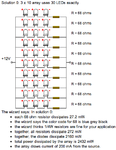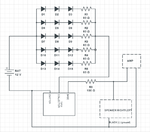nicholasdk
Newbie level 5

- Joined
- Mar 3, 2013
- Messages
- 8
- Helped
- 0
- Reputation
- 0
- Reaction score
- 0
- Trophy points
- 1,281
- Activity points
- 1,348
Hi guys. I'm building a portable soundsystem, and i want some lights on it. I'm thinking of using this guide to get some flashing. I was wondering it this circuit will work? It's 20 LED blurbs with some resistors. I have mainly 2 questions. Which resistors should i choose, i red someting about 1 ohm resistors, is this correct? Can i connect the TiP31 to the loudspeaker, with the red (+??) wire and the black (-??)(ground??) wire? Or can you only connect is by the jack stick? Overall, will this circuit work? Thank you for your help..




